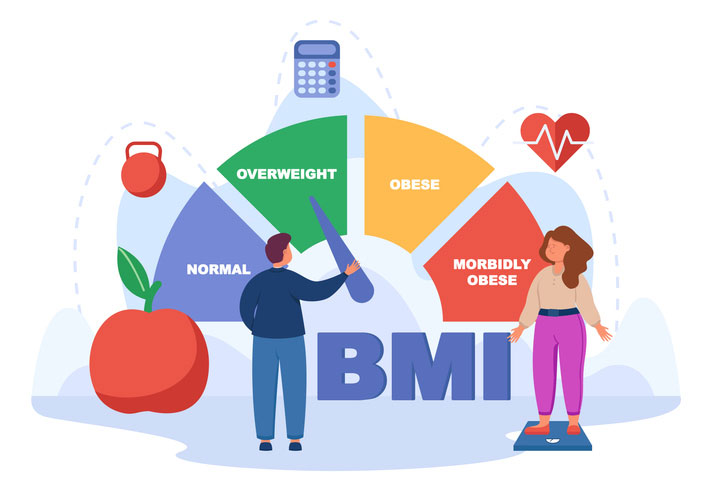Informed skepticism in nutrition involves critically evaluating established health metrics, such as BMI, using evidence-based research. ProfessFord’s studies show that nutrition guidelines don’t apply universally across populations and life stages. Her research found that seniors with higher BMI ranges often have better health outcomes, demonstrating the need for nutrition professionals to adopt contextually focused, outcomes-driven approaches rather than relying solely on standardized metrics.
For over a century, nutrition has undergone a state of constant evolution. In 1894, the US Department of Agriculture (USDA) published its first dietary guide. In it, the nutritional value of food is determined using simple metrics, such as caloric value, and a vague understanding of mineral composition. Dietary recommendations were similarly simple. They were based on occupation and physical activity level, with little else taken into consideration.
The following bachelors and Master’s programs offer career-focused instruction delivered by trained nutritionists with experience in the field. Find out more what each individual course of study offers through the locations below.
Purdue Global's Bachelor of Science in Nutrition Program is an approved holistic nutrition education program through the National Association of Nutrition Professionals (NANP).
The University of Texas at Austin offers an Online Master of Science in Nutritional Sciences.
UNC's MPH Nutrition concentration prepares students to provide, evaluate and communicate nutritional and dietary guidance that improves individual and population-wide health outcomes. In addition to developing their knowledge of nutrition science, students will explore behavior change, communication, counseling and the effects of dietary culture on individuals and communities.
Walden University's Bachelor of Science (B.S.) in Health Studies - Health Promotion and Wellness gains job-ready, immediately applicable skills today's employers want.
The following bachelor’s programs offer career-focused instruction delivered by trained nutritionists with experience in the field. Discover more about what each course of study has to offer through the locations listed below.
By the 1930s, nutritionists had discovered more than just a few vitamins and minerals. They’d found the importance of nuance. During the Great Depression, one popular dietary guide made recommendations at four different price levels. In the 1940s, the USDA promoted the newly established Food Guide Pyramid, which was later revised to the Basic Seven food groups. A poster from the era advises people to eat something from each group every day, but at the bottom, it states, “In addition to the Basic 7… eat any other foods u want.” Like other government agencies, the USDA knew World War II rationing would put a strain on the population. Lean times were likely on the way, and a little extra bulk may help quell initial hunger pangs.
So where does that put you? The USDA’s current dietary guidelines appear to cover a wide range of topics, including food allergies, beverage choices, budgetary considerations, and more. Are we finally in an age of total nutritional enlightenment? Not according to current statistics about the country’s health:
- 19.7% of American children and about 41.9% of adults are obese.
- In 2021, nearly 1 in 2 Americans didn’t eat a daily vegetable.
- Heart disease is responsible for 1 in every three deaths and remains the number one cause of death in the United States.
There’s a disconnect somewhere between what we know and what we think, and it’s literally killing us.
To Professor Dara Ford of a university’s Nutrition EdMaster’s program, tackling this issue means questioning everything she knows about her field and inviting her students to do the same:
“My approach to teaching involves stepping back and taking a hard look at a lot of the traditional measures that we use and examining them with a pretty critical eye.”
But Professor Ford’s critiques of modern nutrition aren’t scattershot, naysaying diatribes built on shaky, unproven evidence-based re-evaluations of what being healthy actually means. Just as importantly, they come from a desire to make healthy living an attainable goal for all. In a recent interview with nutritionED.org, Professor Ford shared how her informed skepticism makes nutrition a more holistic and relevant science.
Table of Contents
- Meet Professor Dara Ford: Champion of Evidence-Based Nutrition
- Why Nutrition Metrics Need Critical Evaluation
- The BMI Paradox: When Higher Numbers Mean Better Health
- Redefining Nutritional Success Beyond Weight Loss
- Teaching Future Nutritionists to Think Critically
- Applying Informed Skepticism in Your Practice
- FAQ: Informed Skepticism in Nutrition Education
- Key Takeaways
 Over the course of her decade-long career in nutrition education, Professor Dara Ford has published many insightful papers on senior health and even helped develop a dietary quality evaluation tool. Currently, Professor Dara Ford is Program Co-Director of a university’s Master of Science in Nutrition Education program. By lecturing in classes such as Life Cycle Nutrition, Nutrition for Health, and Strategies for Weight Control, the school’s Department of Health Studies aims to equip tomorrow’s dietary professionals with a scientific mindset and a profound understanding of the people they serve.
Over the course of her decade-long career in nutrition education, Professor Dara Ford has published many insightful papers on senior health and even helped develop a dietary quality evaluation tool. Currently, Professor Dara Ford is Program Co-Director of a university’s Master of Science in Nutrition Education program. By lecturing in classes such as Life Cycle Nutrition, Nutrition for Health, and Strategies for Weight Control, the school’s Department of Health Studies aims to equip tomorrow’s dietary professionals with a scientific mindset and a profound understanding of the people they serve.
Meet Professor Dara Ford: Champion of Evidence-Based Nutrition
Over the course of her decade-long career in nutrition education, Professor Dara Ford has published many insightful papers on senior health and even helped develop a dietary quality evaluation tool. Her research has challenged conventional thinking about established health metrics, particularly body mass index (BMI) and its application across different age groups and populations.
Currently, Professor Dara Ford is Program Co-Director of a university’s Master of Science in Nutrition Education program. By lecturing in classes such as Life Cycle Nutrition, Nutrition for Health, and Strategies for Weight Control, the Department of Health Studies at the school aims to prepare tomorrow’s dietary professionals with a scientific mindset and a deep understanding of the people they serve.
Ford’s teaching philosophy centers on one core principle: it’s not about hitting arbitrary numbers on a scale. It’s about understanding a person’s unique circumstances, life stage, and health goals. This evidence-based, contextual approach sets her apart in a field that too often relies on one-size-fits-all recommendations.
Her groundbreaking 2014 research on BMI and mortality in older adults has significantly influenced how nutrition professionals approach weight recommendations across the lifespan. Rather than dismissing traditional metrics entirely, Professor Ford encourages students and practitioners to use them wisely, always “asking: “What outcome are we actually trying to “achieve?”
Why Nutrition Metrics Need Critical Evaluation
Like any other science, nutrition is built on quantifiable metrics. The nutritional value of food is measured in terms of fats, sugars, sodium, vitamins, and other essential nutrients. Similarly, nutrition professionals use tools like body mass index (BMI) and blood sugar levels to gauge their clients’ and patients’ progress on their nutritional journeys.
However, these metrics are often misunderstood, misrepresented, and misused. According to Professor Ford, BMI is the perfect example of this phenomenon:
“Body mass index is riddled with really complex and complicated issues. It’s not used as intended. It’s not intended to assess body fat. There are a whole lot of issues with that.”
The Body Mass Index Problem
But why is BMI so complicated? It’s a relatively simple calculation: a person’s mass divided by their height squared. Using this number, healthcare professionals can quickly determine if a person is in a healthy weight range and make recommendations. America’s obesity problem, isn’t BMI the perfect metric to use?
The challenge is that BMI was developed as a population-level screening tool in the 1830s, not as an individual diagnostic measure. It serves as a proxy measure for body fat, not a direct measurement. For many nutritionists and registered dietitians, the problem with BMI is that it lacks nuance when applied to individuals. Underscoring the limitations of BMI is critical for anyone working in nutrition and diet.
- Doesn’t distinguish between muscle and fat – Athletes with high muscle mass often register as “overweight” or “obese”
- Ignores body composition – Two people with the same BMI can have vastly different health profiles
- Fails to account for age differences. What’s healthy for a 25-year-old may not be suitable for a 75-year-old.
- Doesn’t consider ethnicity – According to WHO guidelines, Asian populations may face health risks at lower BMI thresholds than Western populations due to higher body fat percentages at lower weights.
- Overlooks activity levels – Active individuals and sedentary individuals are judged by the same standard
- Misses cardiovascular health markers – Blood pressure, cholesterol, and heart function matter more than the number
- Creates psychological harm – Focusing solely on weight can damage the relationship between practitioners and patients
One of PrFord’s very own studies demonstrates exactly why BMI needs careful interpretation rather than blanket application.
The BMI Paradox: When Higher Numbers Mean Better Health
What PrFord’s Research Revealed
In her 2014 study, Professor Ford and her colleagues found that a BMI of 25 to 29.9 (a range often classified as overweight or pre-obese) was associated with a decreased risk of mortality in seniors. On the other hand, seniors with a BMI of less than 18.5 (underweight) had an increased risk for mortality. While much of the world frets over gaining weight, aging adults may live longer, healthier lives by maintaining a higher BMI in their later years.
This finding challenges decades of conventional wisdom about weight and health. It shows that the same BMI number that signals risk in a 30-year-old might actually protect a 70-year-old. While this association has been observed in some research, it remains a topic of scientific debate and doesn’t apply universally to all populations. Context matters more than we’ve traditionally acknowledged.
Why Older Adults Need Different Standards
Take, for instance, the seniors in PrFord’s study. Strictly speaking, those on the higher end of the BMI scale are outside the recommended ratio. According to standard charts, they need to lose weight. But this metric-focused goal neglects the many benefits maintaining a higher weight can have for aging adults:
- Lower hypertension risks – Higher BMI in old age is associated with lower risks of high blood pressure
- Built-in safety net – Dental, digestive, and other health issues of seniors’ weight are alleviated unintentionally. Added weight can be an effective buffer against illness-related weight loss.
- Better cardiovascular outcomes – Seniors with higher-than-normal BMIs often have higher survival rates when it comes to congenital heart disease and heart failure
- Reserve during illness – Extra weight provides resources the body can use during recovery from illness or surgery
- Bone density protection – Maintaining a higher body weight can help protect bone density and reduce the risk of fractures.k
Critics may say that the advantages don’t always outweigh the other health risks associated with being overweight. And typically, these don’ts don’t extend to younger people in the same BMI range as their elderly counterparts; that’s exactly PrFord’s point. Nutritional guidelines and metrics need to be contextual and focused on broad health outcomes.
In light of these findings, Profess doesn’t advocate for throwing out BMI altogether. Instead, she asks her students to use nutritional metrics with caution and context:
“I encourage students to come into class open-minded and willing to critically assess what the standards are. It’s a real challenge because all of the evidence, all of the tools, all of clinical practice relies on some of these measures that we know are not great.”
If the very standards of nutritional health are problematic, what’s the solution? According to Professor Ford, the answer lies in adopting a more holistic perspective on what constitutes dietary success.

Redefining Nutritional Success Beyond Weight Loss
Given the limitations of metrics like BMI, many nutrition professionals and the people they serve form a dangerously narrow definition of success. Professor Ford sees this issue frequently in nutrition education and the world at large:
“People will say, ‘Oh this diet wasn’t successful.’ But what’s the measure of success? Is it just weight? Because that’s not the same thing as health. We really need to think again about the outcome we’re trying to achieve.”
What True Health Outcomes Look Like
The difference between metric-focused and outcomes-focused nutrition approaches can be dramatic:
| Metric-Focused Approach | Outcomes-Focused Approach |
|---|---|
| Success = Lower number on the scale | Success = Improved energy, mobility, and quality of life |
| BMI must fall within the standard range | Health markers (blood pressure, cholesterol, blood sugar) improve |
| One-size-fits-all guidelines | Personalized based on age, activity, health status, and goals |
| Weight loss at any cost | Sustainable lifestyle changes that improve overall well-being |
| Short-term diet success | Long-term health improvement and disease prevention |
The Whole-Person Perspective
They need to serve people based on where they are in their life cycle, a topic Professor Ford enthusiastically covers in her classes at American University:
“I think the life cycle course is very interesting because most of what we hear really only pertains to a healthy adult population. We examine the tools that are used, but more critically — what are the strict recommendations but also what are the sociocultural implications of those recommendations?”
Fortunately, Professor Ford has seen some recent progress in that regard, but there’s still work to be done:
“We didn’t have recommendations in the dietary guidelines for children under 2 until the 2020 version. But we always need to be evolving. We need to incorporate the standard science with that whole-person perspective.”
The 2020-2025 Dietary Guidelines for Americans marked the first edition to include specific recommendations for children under age 2, representing an essential evolution in recognizing that different life stages require different nutritional approaches.
This evolution of thinking extends beyond age considerations. Accurate outcomes-focused nutrition takes into account:
- Cultural food traditions – Respecting dietary practices that have sustained communities for generations
- Economic realities – Recommendations must be achievable, people’s budgets
- Geographic access – Not everyone has equal access to fresh produce or specialty foods
- Mental health – The psychological impact of rigid dietary rules can outweigh physical benefits
- Social connections – Food is community, and isolation for dietary purity may do more harm than good
- Individual preferences – Sustainable change happens when people enjoy what they eat
Teaching Future Nutritionists to Think Critically

PrFord’s Teaching Philosophy
Even though PrFord’s current schedule at American University includes classes on everything from lifecycle nutrition to epidemiology, she wants all of her students to walk away with at least one crucial lesson: that it isn’t about metrics and it certainly isn’t one-size-fits-all. It’s adaptive, scientifically sound, and outcomes-based:
“That’s an underlying message that persists throughout my classes. My students would probably tell you they’re sick of hearing that from me.”
But as long as there are whole communities besieged by chronic illness and a lack of access to proper nutrition, PrFord’s message bears repeating. There’s no room for complacency.
What Students Learn at American University
In PrFord’s courses at a university’s Department of Health Studies, future nutrition professionals develop critical thinking skills that will serve them throughout their careers:
- Question standard recommendations – Learn when and how to challenge established guidelines
- Evaluate research critically – Distinguish between quality studies and flawed research
- Consider social determinants of health – Understand how poverty, racism, and access affect nutrition
- Apply context to every case – Recognize that textbook doctrines don’t fit every real-world situation
- Prioritize patient relationships – Build trust without judgment, even when clients struggle with recommendations
- Stay current with evolving science – Commit to lifelong learning as nutrition research advances
- Balance evidence with empathy – Use data to inform decisions while remembering you’re serving humans, not numbers
Through classes like Life Cycle Nutrition, Nutrition for Health, and Strategies for Weight Control, students learn to approach nutrition from multiple angles, n’t just memorizing food groups and vitamin requirements. They learn to think like scientists who understand today’s best answer to tomorrow’s outdated practice.
Preparing for Real-World Practice
Suppose nutritionists have to question established guidelines to help people become happier and healthier. The world stands to become a better place because of it.
This approach is especially critical when working with underserved communities. Many populations face barriers to optimal nutrition that have nothing to do with knowledge:
- Limited access to affordable fresh foods
- Food deserts in urban and rural areas
- Cultural disconnect between standard recommendations and traditional diets
- Economic stress that makes nutrition a lower priority than immediate survival needs
- Lack of trust in healthcare systems due to historical mistreatment
Professor Ford prepares her students to work effectively in these real-world contexts, where textbook answers often fall short of the mark. Tisn’tal isn’t to impose rigid standards, it’s to partner with communities in ways that actually improve health outcomes.
Applying Informed Skepticism in Your Practice
For current practitioners, if you’re already working as a nutritionist or registered dietitian, incorporating informed skepticism into your practice means regularly asking:
- Is this recommendation based on current research? – Science evolves, your practice should too
- Does this guideline apply to this specific client? – Age, culture, health status, and goals all matter
- What outcome am I actually trying to achieve? – Weight loss? Improved lab values? Better quality of life? Be clear about your goals
- Am I listening to the client’s lived experience? – They know their body, circumstances, and what’s sustainable for them
- Could there be a better approach for this individual? – Odoesn’t fit all, flexibility is strength, not weakness, doesn’t mean abandoning evidence-based practice. It means applying evidence thoughtfully, with full consideration of the person in front of you.
For Students and Future RDs
Building critical thinking habits starts in your education:
- Ask “why” in every Don’t – Don’t just accept information, understand the research behind it
- Read original studies, not just summaries – Learn to evaluate methodology and spot limitations
- Seek diverse perspectives – Different cultural approaches to nutrition often have valuable wisdom
- Question your own assumptions – We all bring biases, acknowledging them makes you a better practitioner
- Stay humble – The more you learn, the more you’ll realize how much you don’t know about nutrition
Programs like a university’s Master of Science in Nutrition Education explicitly train students in this type of critical thinking. Look for educational programs that emphasize the evaluation of evidence, not just memorization.
FAQ: Informed Skepticism in Nutrition Education
What is informed skepticism in nutrition?
Informed skepticism means critically evaluating nutrition claims, guidelines, and metrics using scientific evidence rather than accepting them at face value. It’s not about rejecting established sites; it’s about understanding the limitations of current knowledge and applying recommendations thoughtfully based on individual context. Informed skepticism requires staying current with research, recognizing that nutrition science is an evolving field, and prioritizing real-world outcomes over rigid adherence to standardized metrics.
Is BMI completely useless as a health metric?
BMI can be a useful screening tool when used as part of a comprehensive health assessment, not as the sole determinant of health. It’s most problematic when applied uniformly across all ages, ethnicities, and activity levels. For the populations it was designed for (general adult screening), it provides a quick estimate. But for athletes, older adults, pregnant women, and many other groups, BMI alone tells an incomplete story. Competent practitioners use BMI in conjunction with other metrics, such as body composition, cardiovascular health markers, and functional assessments, to provide a more comprehensive evaluation of an individual’s overall health.
What other nutrition metrics should be questioned?
Several commonly used nutrition metrics deserve the same critical evaluation as BMI. Daily calorie recommendations often ignore individual metabolic differences and activity levels. Waist-to-hip ratios, while better than BMI in some ways, don’t capture the complete picture of health. Even lab values like cholesterol require contextual interpretation; what’s considered “high” in one context may be normal in another. It isn’t to dismiss these, it’s to recognize that they’re just that: tools, not definitive answers. Use multiple data points and always consider an individual’s circumstances.
How can I find a nutritionist who uses evidence-based approaches?
Look for registered dietitians (RDs) or registered dietitian nutritionists (RDNs) who emphasize individualized care over one-size-fits-all plans. Ask potential nutritionists about their approach to BMI and other metrics. Red flags include: promising quick fixes, demonizing entire food groups without a medical reason, or ignoring your personal circumstances and preferences. Good signs include: asking about your lifestyle and goals, explaining the reasoning behind recommendations, and being willing to adjust plans based on what works for you. Credentials matter; look for RDs with continuing education in areas relevant to your needs.
Where can I learn more about critical nutrition education?
A university’s Master of Science in Nutrition Education program, led by professionals such as Professor Ford, trains students explicitly in evidence-based, critical thinking. The Academy of Nutrition and Dietetics offers continuing education on applying research to practice. Professional journals, such as the Journal of the Academy of Nutrition and Dietetics, publish research on the evolving field of nutrition science. Following nutrition researchers on professional platforms can help you stay current with debates in the field. Any quality nutrition program should teach you not just what to think, but how to think critically about nutrition science.
Does questioning established metrics mean ignoring science?
Actually, it’s the opposite. Questioning established metrics is more scientific, not less. Science is a process of continuous refinement, not a collection of unchangeable facts. The best scientists are those who challenge assumptions and strive for a deeper understanding of the world. Ford’s research on BMI in older adults is a perfect example of scientific skepticism leading to better knowledge. Good science requires asking tough questions: Does this apply in all situations? What are the limitations? Is there a better way?” Informed skepticism strengthens nutrition practice by keeping it grounded in current evidence rather than outdated assumptions.
Key Takeaways
Informed skepticism strengthens, not weakens, the practice of nutrition. By questioning established metrics like BMI with evidence-based research, nutrition professionals can provide better, more personalized care.
Context matters more than numbers. Ford’s research demonstrates that the same BMI range that signals risk in young adults may actually protect older adults. Health recommendations should consider age, life circumstances, and individual goals.
True success is about achieving outcomes, not merely measuring metrics. Weigisn’tss isn’t the same as health improvement. Quality of life, sustainable habits, and overall well-being matter more than hitting arbitrary numbers on charts.
Critical thinking is an essential skill for nutrition professionals. Programs like a university’s Master’s in Nutrition Education train students to evaluate evidence, question assumptions, and apply scientific thought thoughtfully rather than rigidly.
The science of nutrition continues to evolve. “What “we know today may be refined tomorrow. Good practitioners stay humble, keep learning, and adjust their approaches as new evidence emerges.
Whole-person perspectives lead to better care. Considering cultural traditions, economic realities, mental health, and social factors alongside physical metrics creates nutrition plans that actually reflect people’s real lives.
The following bachelors and Master’s programs offer career-focused instruction delivered by trained nutritionists with experience in the field. Find out more what each individual course of study offers through the locations below.
Purdue Global's Bachelor of Science in Nutrition Program is an approved holistic nutrition education program through the National Association of Nutrition Professionals (NANP).
The University of Texas at Austin offers an Online Master of Science in Nutritional Sciences.
UNC's MPH Nutrition concentration prepares students to provide, evaluate and communicate nutritional and dietary guidance that improves individual and population-wide health outcomes. In addition to developing their knowledge of nutrition science, students will explore behavior change, communication, counseling and the effects of dietary culture on individuals and communities.
Walden University's Bachelor of Science (B.S.) in Health Studies - Health Promotion and Wellness gains job-ready, immediately applicable skills today's employers want.
Ready to Pursue Evidence-Based Nutrition Education?
If PrFord’s approach resonates with you, consider exploring advanced nutrition education programs that emphasize critical thinking and evidence-based practice. A university’s Master of Science in Nutrition Education is designed for professionals who want to make a real difference by combining rigorous science with compassionate, individualized care.
you’rer you’re a prospective student exploring nutrition careers or a practicing professional seeking to expand your skills, programs that teach you to think critically, not just memorize guidelines, will prepare you to serve diverse populations effectively.
Explore nutrition degree programs, career paths, and educational requirements to find the right fit for your goals in evidence-based nutrition practice.

